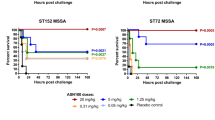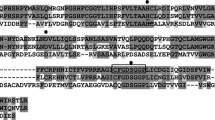Abstract
Elastase has been implicated as a potential virulence factor involved in the invasion process of the opportunistic pathogen,Aspergillus fumigatus. Monoclonal and polyclonal antibodies, known to inhibit elastase in vitro, were employed in an immunocompromised mouse model of invasive aspergillosis to determine if the antibodies could protect mice from fatal infection. Individual monoclonal antibodies, known to inhibit elastase partially (13 to 23%), or combinations of monoclonal antibodies, known to inhibit elastase 70 to 100%, were tested in the mouse model. No individual nor combination of monoclonal antibodies protected immunosuppressed, infected mice in the doses tested. Similarly, elastase-specific polyclonal antibodies, raised in mice or rabbits, did not exhibit a protective effect, nor did immunization of mice with elastase prior to immunosuppression and infection. Histological examination of the lungs of immunosuppressed, infected mice showed no amelioration of fungal invasiveness by treatment with elastase-specific monoclonal or polyclonal antibodies. However, immunocompetent mice, instilled with a spore inoculum much higher than used in the preceding studies and treated with antibodies, survived, while control mice not treated with antibodies were overwhelmed by the massive spore dose and died. Nevertheless, overall evidence suggests that elastase may not be the primary virulence factor involved in invasive pulmonary aspergillosis.
Similar content being viewed by others
References
Kothary MH.Aspergillus fumigatus:. New Brunswick, NJ: Rutgers University, 1983, 157 pp.
Kothary MH, Chase Jr. T, Macmillan JD. Correlation of elastase production by some strains ofA. fumigatus with ability to cause pulmonary invasive aspergillosis in immunocompromised mice. Infect Immun 1984; 43: 320–25.
Monod M, Togni G, Rahalison L, Frenk E. Isolation and characterisation of an extracellular alkaline protease ofAspergillus fumigatus. J Med Microbiol 1991; 35: 23–38.
Reichard U, Buttner S, Eiffert H, Staib F, Ruchel R. Purification and characterisation of an extracellular serine proteinase fromAspergillus fumigatus and its detection in tissue. J Med Microbiol 1990; 33: 243–51.
Rhodes JC, Amlung TW, Miller MS. Isolation and characterization of an elastinolytic proteinase fromAspergillus flavus. Infect Immun 1990; 58: 2529–34.
Rhodes J, Amlung T. Elastase-deficientAspergillus flavus has reduced virulence in mice. Annual Meeting of the American Society for Microbiology. Abstract No. F-31, 1990.
Kolattukudy PE, Lee JD, Rogers LM, Zimmerman P, Ceselski S, Fox B, Stein B, Copelan EA. Evidence for possible involvement of an elastolytic serine protease in aspergillosis. Infect Immun 1993; 61: 2357–68.
Frosco MB, Fahed C, Chase Jr. T, Macmillan JD. Inhibition ofAspergillus fumigatus elastase with monoclonal antibodies produced by using denatured elastase as an immunogen. Infect Immun 1992; 60: 735–41.
Sato H, Sato Y. Protective activities in mice of monoclonal antibodies against pertussis toxin. Infect Immun 1990; 58: 3369–74.
Frosco MB. The role of elastase in the invasion process of the opportunistic pathogenAspergillus fumigatus [Dissertation]. New Brunswick, NJ: Rutgers University, 1992, 147 pp.
Frosco MB, Chase Jr. T, Macmillan JD. Purification and characterization of elastase fromAspergillus fumigatus. Infect Immun 1992; 60: 728–34.
Dixon DM, Polak A, Walsh TJ. Fungus dose-dependent primary pulmonary aspergillosis in immunosuppressed mice. Infect Immun 1989; 57: 1452–56.
Mancini G, Carbonara AO, Heremans JF. Method of single radial immunodiffusion. Immunochemistry 1965; 2: 235–54.
Abe F, Katoh T, Kaneko T, Hotchi M. Effects of endotoxin lipopolysaccharides on experimental aspergillosis in leukemic mice. Mycopathologia 1987; 99: 95–97.
Baisakh KM, Agarwal DS, Iyengar B, Bhatia VN. Experimental aspergillosis and phycomycosis in mice. Indian J Med Res 1975; 63: 1716–31.
Jensen HE, Hau J. A murine model for the study of the impact ofAspergillus fumigatus inoculation on the foetoplacental unit. Mycopathologia 1990; 112: 11–18.
Piggott WR, Emmons CW. Device for inhalation exposure of animals to spores. Proc Soc Exp Biol Med 1960; 103: 805–6.
Sidransky H, Epstein SM, Verney E, Horowitz C. Experimental visceral aspergillosis. Am J Pathol 1972; 69: 55–67.
Williams DM, Weiner MH, Drutz DJ. Immunologic studies of disseminated infection withAspergillus fumigatus in the nude mouse. J Infect Dis 1981; 143: 726–733.
Land CJ, Sostaric B, Fuchs R, Lundstrom H, Hult K. Intratracheal exposure of rats toAspergillus fumigatus spores isolated from sawmills in Sweden. Appl Environ Microbiol 1989; 55: 2856–60.
Phillips P, Radigan G. Antigenemia in a rabbit model of invasive aspergillosis. J Infect Dis 1989; 159: 1147–50.
Spreadbury CL, Krausz T, Pervez S, Cohen J. Invasive aspergillosis: clinical and pathological features of a new animal model. J Med Vet Mycol 1989; 27: 5–15.
Sidransky H, Verney E. Experimental aspects: experimental aspergillosis. Lab Invest 1962; 11: 1172–83.
Monod M, Paris S, Sarfati J, Jaton-Ogay K, Ave P, Latgé JP. Virulence of alkaline protease-deficient mutants ofAspergillus fumigatus. FEMS Microbiol Lett 1993; 106: 39–46.
Tang CM, Cohen J, Krausz T, Noorden S, Holden DW. The alkaline protease ofAspergillus fumigatus is not a virulence factor in two murine models of invasive aspergillosis. Infec Immun 1993; 61: 1650–56.
Author information
Authors and Affiliations
Rights and permissions
About this article
Cite this article
Frosco, MB., Chase, T. & Macmillan, J.D. The effect of elastase-specific monoclonal and polyclonal antibodies on the virulence ofAspergillus fumigatus in immunocompromised mice. Mycopathologia 125, 65–76 (1994). https://doi.org/10.1007/BF01371095
Received:
Accepted:
Issue Date:
DOI: https://doi.org/10.1007/BF01371095




